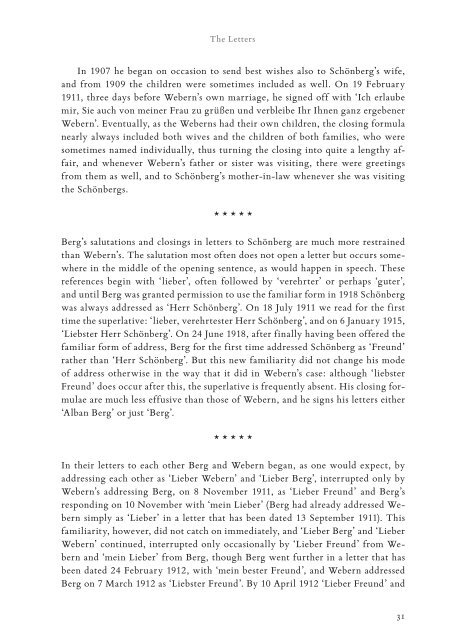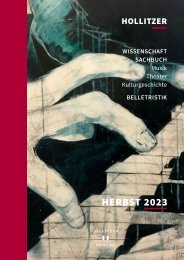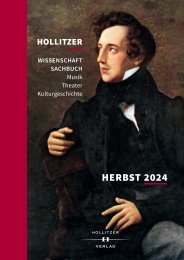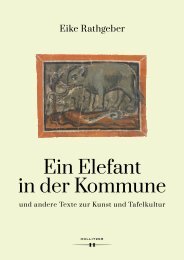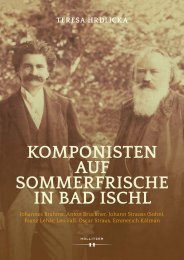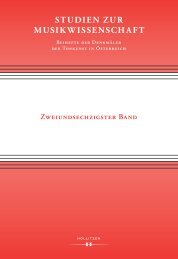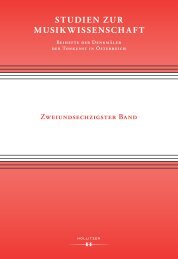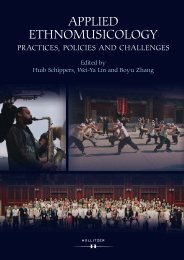Leseprobe_Three Men of Letters
Create successful ePaper yourself
Turn your PDF publications into a flip-book with our unique Google optimized e-Paper software.
The <strong>Letters</strong><br />
In 1907 he began on occasion to send best wishes also to Schönberg’s wife,<br />
and from 1909 the children were sometimes included as well. On 19 February<br />
1911, three days before Webern’s own marriage, he signed <strong>of</strong>f with ‘Ich erlaube<br />
mir, Sie auch von meiner Frau zu grüßen und verbleibe Ihr Ihnen ganz ergebener<br />
Webern’. Eventually, as the Weberns had their own children, the closing formula<br />
nearly always included both wives and the children <strong>of</strong> both families, who were<br />
sometimes named individually, thus turning the closing into quite a lengthy affair,<br />
and whenever Webern’s father or sister was visiting, there were greetings<br />
from them as well, and to Schönberg’s mother-in-law whenever she was visiting<br />
the Schönbergs.<br />
* * * * *<br />
Berg’s salutations and closings in letters to Schönberg are much more restrained<br />
than Webern’s. The salutation most <strong>of</strong>ten does not open a letter but occurs somewhere<br />
in the middle <strong>of</strong> the opening sentence, as would happen in speech. These<br />
references begin with ‘lieber’, <strong>of</strong>ten followed by ‘verehrter’ or perhaps ‘guter’,<br />
and until Berg was granted permission to use the familiar form in 1918 Schönberg<br />
was always addressed as ‘Herr Schönberg’. On 18 July 1911 we read for the first<br />
time the superlative: ‘lieber, verehrtester Herr Schönberg’, and on 6 January 1915,<br />
‘Liebster Herr Schönberg’. On 24 June 1918, after finally having been <strong>of</strong>fered the<br />
familiar form <strong>of</strong> address, Berg for the first time addressed Schönberg as ‘Freund’<br />
rather than ‘Herr Schönberg’. But this new familiarity did not change his mode<br />
<strong>of</strong> address otherwise in the way that it did in Webern’s case: although ‘liebster<br />
Freund’ does occur after this, the superlative is frequently absent. His closing formulae<br />
are much less effusive than those <strong>of</strong> Webern, and he signs his letters either<br />
‘Alban Berg’ or just ‘Berg’.<br />
* * * * *<br />
In their letters to each other Berg and Webern began, as one would expect, by<br />
addressing each other as ‘Lieber Webern’ and ‘Lieber Berg’, interrupted only by<br />
Webern’s addressing Berg, on 8 November 1911, as ‘Lieber Freund’ and Berg’s<br />
responding on 10 November with ‘mein Lieber’ (Berg had already addressed Webern<br />
simply as ‘Lieber’ in a letter that has been dated 13 September 1911). This<br />
familiarity, however, did not catch on immediately, and ‘Lieber Berg’ and ‘Lieber<br />
Webern’ continued, interrupted only occasionally by ‘Lieber Freund’ from Webern<br />
and ‘mein Lieber’ from Berg, though Berg went further in a letter that has<br />
been dated 24 February 1912, with ‘mein bester Freund’, and Webern addressed<br />
Berg on 7 March 1912 as ‘Liebster Freund’. By 10 April 1912 ‘Lieber Freund’ and<br />
31


